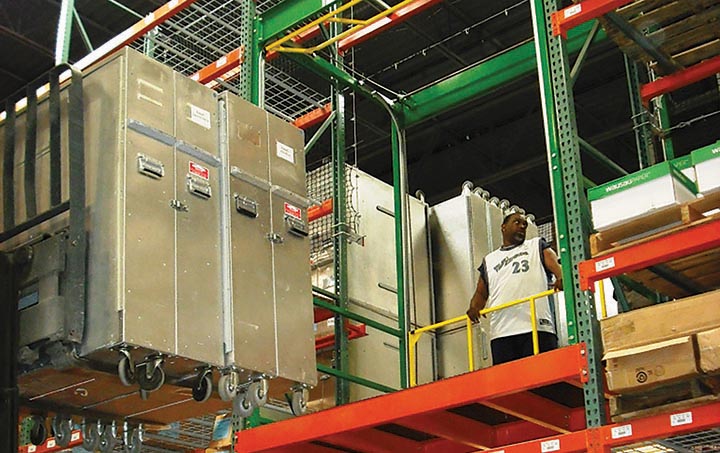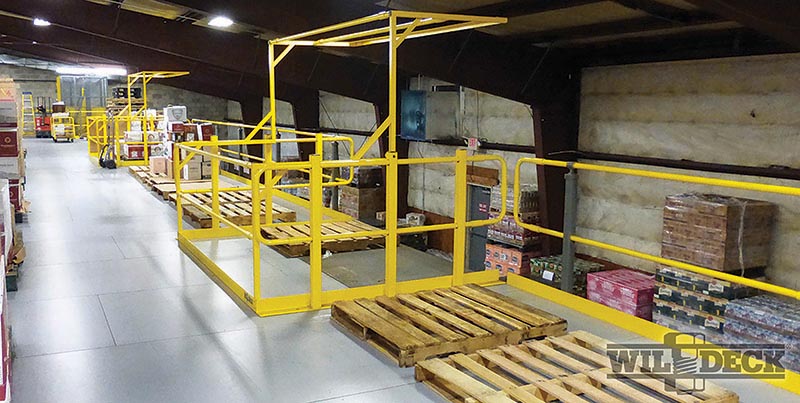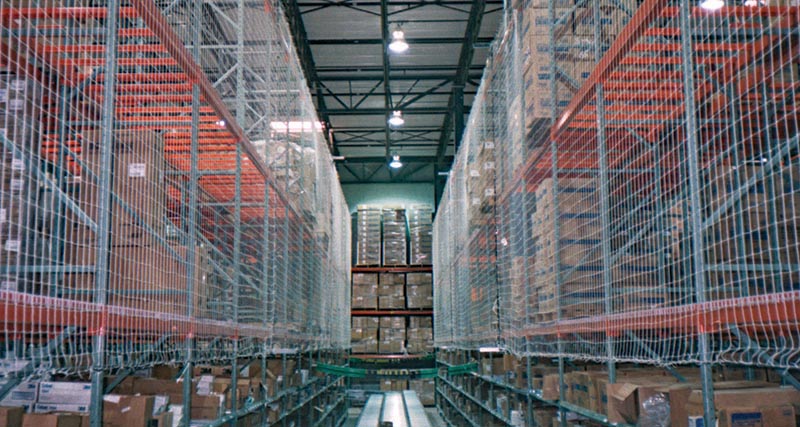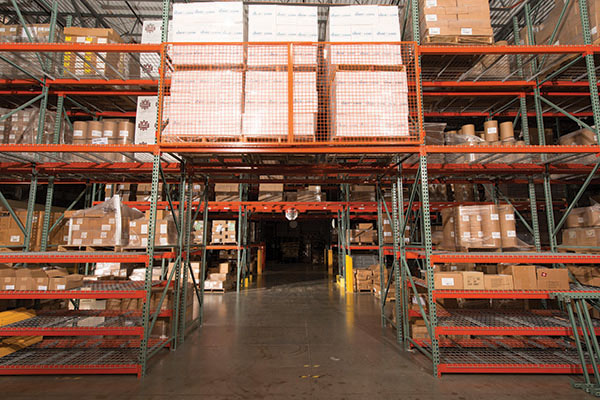When the subject of maintenance comes up, the usual focus is some type of equipment.
Conveyors or lift trucks, for instance. And, the answer is a preventive or even predictive maintenance program. Makes sense.
But when it comes to protecting people, equipment and inventory all at the same time, a highly effective preventive maintenance program focuses on the installation of guarding. These simple tools deserve consideration if any of these five scenarios might occur in your facility.
- A box falls off a rack from the second or third level.
- A lift truck hits a rack.
- A worker catches himself just before stepping off the edge of a mezzanine loading area.
- A box drops off an overhead conveyor and barely misses someone on the floor.
- A worker (looking at a phone) strays into the lift truck travel lane.
Hopefully, none of these are an everyday occurrence in your facility, but they don’t even have to occur every day. All it takes is one worker compensation claim for an injured employee or an insurance claim for damaged inventory to strongly make the case for guarding.
Fortunately, plenty of options to protect people, equipment and inventory from falls are available. These include guardrail, netting, wire mesh partitions, mezzanine safety guards and rack guards. This really is preventive maintenance of the first order. For a dozen ways proper guarding can protect your workers and materials, see the box on pg. 17.
“Too often, operations managers don’t consider installing this safety equipment until after an incident,” says Ray Niemeyer, director of business development at SpaceGuard Products. But, it doesn’t have to be like that.
“Operations managers need to be proactive in protecting their investments in people, equipment and inventory,” adds Cory Thomas, product manager for guarding products at Wildeck.
“This equipment is about protecting people and inventory from falls while keeping stationary equipment such as racks in good shape,” says Aaron Conway, president of Mezzanine Safeti-Gates.
If most of this equipment weren’t bright yellow, it would be easy to overlook it in the plant or warehouse. “All types of guarding are much more effective than yellow lines painted on the floor,” points out Stephen Pembshaw, director of sales at Visiplas.
Increased guarding use
Increased emphasis on safety in facilities is a strong driver of guarding solutions these days. So is a strong economy and the speed of operations in e-commerce facilities, says Bill Kiel, president of Carron Net.

Safety gates on mezzanines protect workers from falls.
Kiel continues to say that guarding is now regularly included the initial facility design rather than as a retrofit. Both original equipment suppliers and systems designers are responsible for this shift.
“We see more use of guarding in the latest designs and installations. And many of these are more vertical than in the past, including broader use of overhead conveyor systems,” adds Kiel.
In addition, everyone is under pressure to maximize the use of space in plants and warehouses. More of everything is being squeezed horizontally and vertically between the four walls. It all adds up to greater risk of accidents just to get through the day.

Guarding is becoming part of initial facility designs.
Strongly promoting use of guards in all forms is a group known as ProGMA (Protective Guarding Manufacturers) of the industry trade association MHI.
The group has released several instructional videos on the value of each type of guarding, says Niemeyer, who is also the chairman of the ProGMA group. The videos can be found at mhi.org/progma/videos.
In addition, ProGMA is working on two new ANSI standards, explain Niemeyer and vice-chair Conway. One standard is for steel mesh and the other for guardrails and barriers. Each standard will educate operations managers on the importance of these products while clarifying expected product performance, say Niemeyer and Conway. Both standards are expected to be released in the next six to 18 months.
The value of guarding
Ask most people what comes to mind when they think of guarding and the typical response is rack guards and guardrail. Not only are they often bright yellow, but probably the majority of facilities use one or the other if not both.
Let’s start with rack guards. As Pembshaw of Visiplas points out, these come in two general types. One is a steel protector on the corner uprights of rack. They are heavier duty than plastic guards and are better able to protect against lift truck impact as drivers cut the corner in the travel lane. Plastic guards are typically used on intermediate uprights that tend to be hit by pallets loads or other unit loads rather than lift trucks.
At the ProMat show next year, Visiplas plans to introduce a new pallet deflector. It is an additional guard at the base of the upright. The round pallet deflector fits completely around the base of the upright, providing an additional protection against impact from pallet loads. “The pallet deflector will reduce pallet rack maintenance up to 90%,” says Pembshaw.
Guardrails typically keep people out of lift truck pallet lanes. Other applications include protection of stairs and dock areas.
Both polymer and steel guardrails are available with the latter typically less expensive than the former. However, some industries such as food and beverage tend to prefer polymer for its cleanliness over time.
Where protective guarding can help
A careful review of the plant or warehouse identifies many opportunities to use any of several forms of guarding to protect people, equipment and inventory. Here are 12 key questions that MHI’s industry group ProGMA recommends be asked.
- Are pedestrian aisle ways defined and physically separated from industrial vehicle traffic conveyors and robotic equipment?
- Is perimeter guarding installed around automated equipment, and does it meet guidelines published by OSHA or the Robotic Industry of America?
- Are overhead conveyors guarded so that falling objects will be safely contained?
- Are rack and shelving systems guarded to prevent loose objects from falling into walkways, work areas or flues?
- Are materials handling entry points to fixed equipment and work cells properly guarded from vehicle traffic?
- Are pallet rack uprights in high traffic areas, tunnel bays or end of rows protected from impact?
- Are building columns in high vehicle traffic areas properly protected?
- Do mezzanines, elevated work platforms and load/unload areas have proper guarding to prevent people or products from falling?
- Are shipping docks protected from damage, falls or unauthorized entry?
- Are vertical ladders protected from falls?
- Are fixed structures such as racks, in-plant offices, electrical equipment or sprinkler main lines protected from industrial vehicle traffic?
- Are personnel in designated work cells isolated from vehicle traffic?
Guardrails offer three levels of protection, says Thomas of Wildeck. Light-duty guardrails are a physical barrier but are intended primarily to provide a visual outline of where people and equipment belong on the floor. Medium-duty guardrail offer 40% higher protection with a 10,000-pound impact rating for a truck traveling 4 mph. Heavy duty goes one level higher, providing 60% greater protection than light-duty with a 13,000-pound impact rating at 4 mph.
Safety gates also figure prominently in the guarding story. They are typically used to protect people from falls in dock areas, from mezzanines, in pallet flow lanes and other elevated surfaces.
Mezzanine Safeti-Gates has just released a new line of dock safety gates that provide fall protection, says Conway. The gates can be opened only when a trailer is backed into the dock.
These gates follow the development of a dock-lift gate that was the result of a fatality at a facility. They secure the edge of the loading dock lifts, pit-mounted dock lifts and scissor lifts.
Another new equipment release from Mezzanine Safeti-Gates is a pallet flow gate that keeps people out of lanes on mezzanines and rack-supported pick modules. Dual counterbalanced gates allow pallet loading while creating a fall-protection barrier for people on the platform at all times, says Conway.
Meanwhile, Wildeck recently introduced an Edge Alert accessory for any type of gate at an elevated surface. Both a visual flashing light and audible alarm activate when the gate is open.
Wire mesh partitions can be used to control access and secure inventory almost anywhere in a plant or warehouse, says SpaceGuard’s Niemeyer. Pallet rack safety is a primary use of wire mesh. It prevents products from falling from a rack bay and injuring a person below. Partitions also define new work areas as well as create quarantine cages right on the floor.
The final guarding tool is netting. Nylon netting is similar to wire mesh partitions, protecting people from inventory falling from racks or overhead conveyors, to name two applications.

Industrial netting partitions control access to inventory in the warehouse.
As Kiel of Carron Net explains, “netting is both flexible and relatively inexpensive, allowing operations managers to change how it is used as inventory and workflows change in the facility.” That makes netting especially practical in high-speed e-commerce DCs constantly adapting to shifts in consumer demand.
Guarding of all types is taking on an increasingly important role in facilities as more people realize its importance to protecting people, equipment and inventory.
Companies mentioned in this article:
Carron Net
Mezzanine Safeti-Gates
ProGMA (Protective Guarding Manufacturers)
SpaceGuard Products
Visiplas
Wildeck
Article topics








